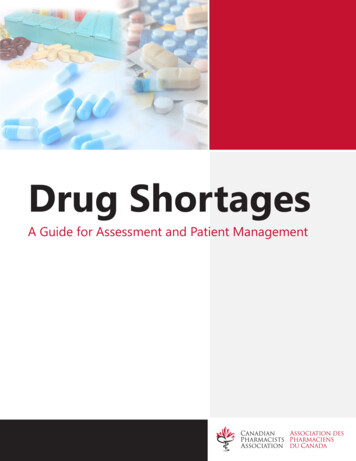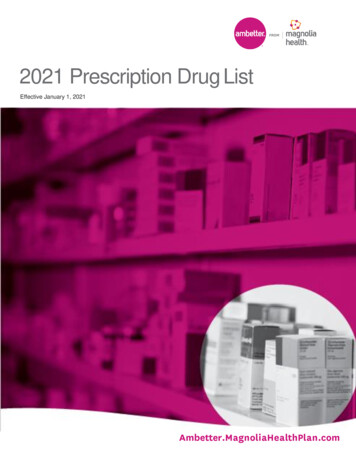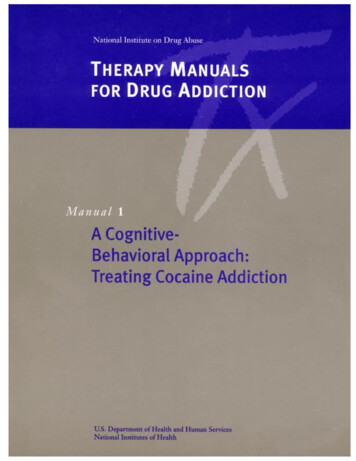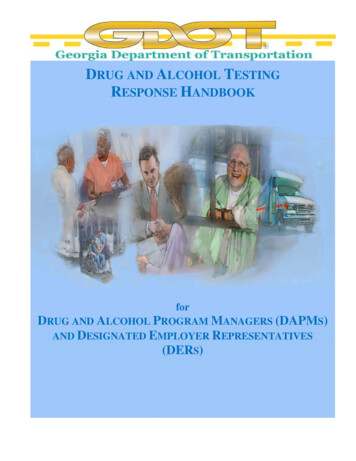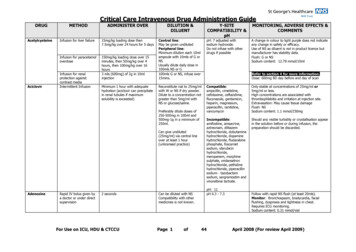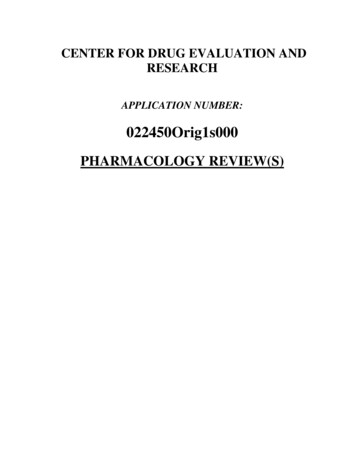
Transcription
CENTER FOR DRUG EVALUATION ANDRESEARCHAPPLICATION NUMBER:022450Orig1s000PHARMACOLOGY REVIEW(S)
5 Page(s) of Draft Labeling have been Withheld in Full as b4 (CCI/TS) immediately following thispage
(b) (4)(b) (4)
(b) (4)(b) (4)
COPYRIGHT MATERIAL
(b) (4)(b) (4)
COPYRIGHT MATERIAL
(b) (4)(b) (4)
COPYRIGHT MATERIAL(b) (4)
(b) (4)(b) (4)
COPYRIGHT MATERIAL
COPYRIGHT MATERIAL
COPYRIGHT MATERIAL
(b) (4)(b) (4)
(b) (4)(b) (4)(b) (4)(b) (4)(b) (4)(b) (4)
(b) (4)(b) (4)(b) (4)(b) (4)(b) (4)
(b) (4)(b) (4)(b) (4)
(b) (4)
COPYRIGHT MATERIALCOPYRIGHT MATERIAL
COPYRIGHT MATERIAL
COPYRIGHT MATERIALCOPYRIGHT MATERIAL
COPYRIGHT MATERIALCOPYRIGHT MATERIALCOPYRIGHT MATERIAL(b) (4)
(b) (4)
(b) (4)(b) (4)COPYRIGHT MATERIAL
COPYRIGHT MATERIAL(b) (4)(b) (4)
(b) (4)
(b) (4)
Pharmacology Toxicology Review AddendumExecutive SummaryI.RecommendationsA. Recommendation on approvabilityFrom the nonclinical pharmacology perspective, NDA 22-450 is recommendedfor approval.B. Recommendation for nonclinical studiesAt this time, there are no nonclinical studies needed that will impactapprovability.C. Recommendation on labelingThe table below contains the draft labeling submitted by the sponsor, theproposed changes and the rationale for the proposed changes for the nonclinicaltoxicology section only. Please see the secondary review for final labelingrecommendations.(b) (4)1
Reviewer: Carlic K. Huynh, Ph.D.NDA No. 22-450(b) (4)II.Summary of nonclinical findingsA. Brief overview of nonclinical findingsFrom the previous pharmacology toxicology review of this NDA, acetaminophenis not a mutagen (as demonstrated by negative results in the bacterial Ames test)but is a clastogen (as demonstrated by positive results in the chromosomalaberration assay in cultured human peripheral blood lymphocytes).2
Reviewer: Carlic K. Huynh, Ph.D.NDA No. 22-450From the previous pharmacology toxicology review of this NDA, the results ofthe NTP carcinogenicity studies showed that there was no evidence ofcarcinogenic activity of acetaminophen in male F344/N (Fischer) rats, there wassome evidence of carcinogenic activity in female rats based on an increasedincidence of mononuclear cell leukemia (although this finding is believed to be oflimited human relevance), and there was no evidence of carcinogenic activity inmale and female B6C3F1 mice.From the previous pharmacology toxicology review of this NDA, testicularatrophy and reduction in testis weight was noted in fertility studies ofacetaminophen performed on rats at all doses tested. There were no fetalmorphological abnormalities but dose-dependent microscopic lesions of thematernal liver and kidney in rats as well as retarded growth and abnormal spermin F1 mice and reduced birth weight of F2 pups in embryo and teratogenicitystudies done in rodents.The Sponsor has submitted a continuous feed study (NTP-1984) of up to 1.0%APAP in CD-1 mice to demonstrate decreased fertility in the F0 generation anddecreased pup weights in the F1 and F2 generations. There was also an increasedamount of abnormal sperm in the F1 males. However, the fertility andreproductive study on APAP was conducted using orally administered APAP.Although the fertility and reproductive study on APAP did not examine theskeletal malformations, the pups were examined grossly for any malformations.B. Pharmacologic activityAcetaminophen is a non-opioid analgesic and non-salicylate antipyreticcompound. A definitive mechanism of action for acetaminophen has not beenelucidated. The use of IV acetaminophen in the proposed indication of thetreatment of acute pain and fever in adult and pediatric patients is supportedthrough the various mechanisms of action of acetaminophen, including a centralsite of action, prostaglandin inhibition, and cannabinergic and serotonergiceffects. Namely, transformation of acetaminophen in the CNS to form AM404can then stimulate vanilloid receptors (TRPV1) to increase the activity ofendogenous cannabinoids and to exert anti-nociceptive and hypothermic effects.C. Nonclinical safety issues relevant to clinical useThe Sponsor submitted a study reproductive and developmental toxicologyconducted by the National Toxicology Program (NTP-1984). The study was acontinuous feed study of up to 1.0% APAP in CD-1 mice to demonstratedecreased fertility in the F0 generation and decreased pup weights in the F1 and F2generations. There was also an increased amount of abnormal sperm in the F1males. Moreover, exposure to APAP leads to testicular changes in various ratstudies from the published scientific literature (Boyd-1968, Ratnasooriya-2000,and Yano and Dolder-2002).3
Reviewer: Carlic K. Huynh, Ph.D.NDA No. 22-450There is a drug product degradant, 4-aminophenol (4-AP). In the proposed drug(b) (4)product specifications, 4-AP is NMT. The Sponsor has submittedreferences and studies to elucidate the metabolism, reproductive toxicity, genetictoxicity, and carcinogenicity of 4-AP. 4-AP is not mutagenic but is clastogenic.From a clinical PK study of orally administered 1-4 g APAP, 4-AP is not a majormetabolite. Up to 30 mg/kg/day 4-AP did not increase the incidence of neoplasticlesions in a 2-year rat carcinogenicity assay. The reproductive toxicology studiesfrom the literature demonstrate that 4-AP is associated with dose-related increasein fetal malformations, a high incidence of fetal resorption, decrease in maternalbody weight, decreased postpartum pup weight, tail abnormalities, and/or hindlimb paralysis, as well as perinatal loss. These reproductive toxicology studiessubmitted by the Sponsor employed the oral route of administration.4
Reviewer: Carlic K. Huynh, Ph.D.NDA No. 22-450FDA Center for Drug Evaluation and ResearchDivision of Anesthesia, Analgesia, and Rheumatology Products10903 New Hampshire Avenue, Silver Spring, MD 20993ADDENDUMMEMO TO FILEIND number:Sponsor:Submission Type:Supporting Doc Number:Submission Date/Receipt:Drug Substance:Reviewer name:Supervisor name:Division name:Review completion date:22-450Cadence Pharmaceuticals, Inc.12481 High Bluff Drive, Suite 200San Diego, CA 92130Original NDA21, 25, 29, 30, 34, and 35October 21, 2009 / October 21, 2009 (SDN 21)November 4, 2009 / November 4, 2009 (SDN 25)December 1, 2009 / December 2, 2009 (SDN 29)December 4, 2009 / December 4, 2009 (SDN 30)December 14, 2009 / December 15, 2009 (SDN 34)January 13, 2010 / January 14, 2010 (SDN 35)AcetaminophenCarlic K. Huynh, Ph.D.R. Daniel Mellon, Ph.D.Division of Anesthesia, Analgesia, andRheumatology ProductsJanuary 20, 2010Recommendation: From a nonclinical pharmacology/toxicology perspective, NDA 22450 is recommended for approval.Background/Prior Regulatory History:On November 10, 2009, the Sponsor was granted a 3-month extension to the review cycledue to the submission of a major amendment. Additional supporting documents havebeen submitted by the Sponsor or have been obtained by the nonclinical pharmacologytoxicology review team since the nonclinical review of this NDA was sent to the Sponsoron November 3, 2009 and are evaluated in this addendum.Reproductive toxicology of APAP:Regarding the reproductive toxicology of APAP, there is a final report of a reproductionand fertility study preformed on CD-1 mice when administered APAP in feed from theNTP (1984). NOTE: Acetaminophen (APAP) is abbreviated as ACET in this study.5
Reviewer: Carlic K. Huynh, Ph.D.NDA No. 22-450CD-1, (ICR)BR outbred albino mice were fed a diet consisting of 0.25, 0.5, and 1.0%APAP in the continuous breeding phase of the study. It is noted that 0.25, 0.5, and 1.0%APAP correspond to 2.5, 5.0, and 10.0 mg/g APAP, respectively. It is noted that Reel1992 had summarized this NTP study and determined the mice ingested 357, 715, and1430 mg/kg APAP, respectively. The continuous breeding phase consists of a 7-daypremating exposure, a 98-day cohabitation period, and a 21-day segregation period. Thecontinuous breeding phase lasts for a total of 18 weeks.Continuous exposure of CD-1 mice to 0.25, 0.5, and 1.0% APAP had no effect on theproportion of pairs able to produce at least one litter.Table 1 shows the reproductive performance of the fertile pairs during treatment withdietary APAP.Table 1: Reproductive Performance of Fertile Pairs During Continuous BreedingBEST AVAILABLECOPYaMean S.E. for all litters delivered per fertile pair.Number of fertile pairs providing data indicated in parenthesis.cSignificantly different (p 0.05) from the 0.0 and 0.25% APAP groups.dSignificantly different (p 0.05) from the 0.25% APAP group.eSignificantly different (p 0.05) from the 0.5% APAP group.fMean adjusted for total number of live and dead pups per litter by analysis of covariance.gSignificantly different (p 0.05) from the 0.0% APAP group.hSignificantly different (p 0.01) from the 0.5% APAP group.iSignificantly different (p 0.01) from the 0.0% APAP group.jSignificantly different (p 0.01) from the 0.25 and 0.5% APAP groups.bExposure to 1.0% APAP in the diet caused a significant reduction (p 0.05) in the numberof litters per pair relative to the 0.0 and 0.25% APAP groups. Moreover, mice fed dietarylevels of 1.0% APAP had a decreased number of live male pups per litter (p 0.05) ascompared to mice receiving 0.0 or 0.25% APAP in their diet. Dietary APAP had noeffect on the number of live female pups per litter. There was no effect of these dietarylevels of APAP on the proportion of pups born alive, the sex of pups born alive, and the6
Reviewer: Carlic K. Huynh, Ph.D.NDA No. 22-450absolute pup weight. There was no dose-dependent effect of these dietary levels ofAPAP on the adjusted live pup weight.Since APAP had no effect on fertility and only relatively minor effects on reproductiveperformance in F0 breeding pairs, the reproductive effects of APAP in the F1 generationwas evaluated. The litters from the continuous breeding phase (0, 0.25, 0.5, and 1.0%APAP dose groups) were weaned at 28 days of age and 9 or 10 litters were randomlyselected for rearing. The litter groups were maintained at the same dietary levels as theirparents (F0 generation). At 74 10 days of age, one to three males and females fromeach of these litters were randomly selected for breeding within each dose group andwere cohabitated for 7 days. The pairs were then separated and the females were allowedto deliver their litters (F2 generation). Exposure to dietary levels of APAP continuedduring cohabitation and pregnancy. At the conclusion of this phase of the study, grossnecropsy and histopathology was performed.The body weights of the F1 mice at birth (day 0), at weaning (28 days of age), and atmating (74 10 days of age) were taken and shown in Table 2.Table 2: Body Weight of F1 Generation at Birth (Day 0), Weaning (Day 28), and atthe Outset of the Mating Trial (Day 74 10): Effect of Continuous Exposure toAPAPBEST AVAILABLECOPYaMean male or female pup weight per litter; number of litters evaluated indicated in parenthesis belowmean Bale and female pup weight per litter.bMean for individual pup weights; number of pups weighed indicated in parenthesis below the mean pupweight.cSignificantly different from the 0% APAP group (p 0.05).dSignificantly different from the 0% APAP group (p 0.01).eMean for individual mice; number of mice weighed indicated in parenthesis below the mean mouseweight.Table 2 shows that there was a significant dose-dependent decrease in the body weightsof F1 pups at weaning and at mating (p 0.05 or p 0.01), indicating APAP toxicity duringlactational and postweaning periods. In contrast, continuous exposure of F1 mice toAPAP in utero and from birth to 74 10 days of age had no statistically significanteffects on the proportion of detected matings, fertile pairs, pups born alive or sex of pupsborn alive (males/total) relative to the control F1 mice.Table 3 shows the reproductive performance of fertile pairs of F1 mice after continuousexposure to APAP.7
Reviewer: Carlic K. Huynh, Ph.D.NDA No. 22-450Table 3: Reproductive Performance of Fertile Pairs of F1 Mice After a Mating Trialto Determine the Effect of Continuous Exposure to APAPBEST AVAILABLECOPYaMean S.E. for the one litter delivered per fertile pair.Number of fertile pairs providing data indicated in parenthesis.cSignificantly different (p 0.05) from the 0.0 and 1.0% APAP groups.dSignificantly different (p 0.05) from the 0.0% APAP group.eSignificantly different (p 0.01) from the 0.25 and 1.0% APAP groups.fSignificantly different (p 0.05) from the 0.25% APAP group.gSignificantly different (p 0.01) from the 0.0, 0.25 and 0.5% APAP groups.hMean adjusted for total number of live and dead pups per litter by analysis of covariance.bAs shown in Table 3, there was a significant decrease (p 0.01) in the absolute andrelative live pup weight (F2 generation) in the 1.0% APAP treatment group versus that inthe 0.0, 0.25, and 0.5% APAP treatment groups.Mice from the 0.0 and 1.0% APAP-exposed F1 mice were weighed and necropsied at theconclusion of this phase of the study.Sperm assessment was performed in the high dose male mice and are shown in Table 4.Table 4: Sperm Analysis for F1 Mice: Effect of Continuous Exposure to APAPBEST AVAILABLECOPYaMean S.E.Number of observations indicated in parenthesis.cTailless sperm were not included in the determination of abnormal sperm.dSignificantly different (p 0.01) from the 0.0% APAP group.b8
Reviewer: Carlic K. Huynh, Ph.D.NDA No. 22-450eTail-less sperm were found to be an artifact of the method used to prepare sperm suspensions. Macerationof the cauda epididymis appeared to cause the loss of tails from many of the spermatozoa.As shown in Table 4, sperm assessment indicated no significant difference in the %motile sperm or sperm concentration in the cauda epididymis between male mice given0.0 and 1.0% APAP in the diet. In contrast, the % abnormal sperm in the cauda wassignificantly elevated (p 0.01) in the males exposed to 1.0% APAP in the diet comparedto the male control group.Body and organ weights of the F1 males following dietary treatment of 0.0 and 1.0%APAP are presented in Table 5.Table 5: Male Body Weight and Organ Weights of F1 Rats at NecropsyBEST AVAILABLECOPYaMean S.E.Number of observations indicated in parenthesis.cOne male body weight was inadvertently not taken in the 1.0% APAP group.dSignificantly different (p 0.01) from the 0.0% APAP group.eSignificantly different (p 0.05) from the 0.0% APAP group.fOne pituitary gland lost in the 1.0% APAP group due to improper dissection.bAs shown in Table 5, body weight (p 0.01) and liver (p 0.01), brain (p 0.01), pituitary(p 0.05) and right epididymal (p 0.01) weights were significantly decreased in the F1male mice fed 1.0% APAP in the diet relative to F1 male mice given the control diet.Body and organ weights of the F1 females following dietary treatment of 0.0 and 1.0%APAP are presented in Table 6.Table 6: Female Body Weight and Organ Weights of F1 Rats at Necropsy9
Reviewer: Carlic K. Huynh, Ph.D.NDA No. 22-450BESTAVAILABLECOPYaMean S.E.Number of observations indicated in parenthesis.cTwo female body weights inadvertently not taken.dOne female body weight inadvertently not taken.eSignificantly different (p 0.01) from the 0.0% APAP group.fSignificantly different (p 0.05) from the 0.0% APAP group.bAs shown in Table 6, body weight (p 0.01) as well as brain (p 0.05) and pituitary(p 0.01) weight also were significantly decreased in F1 female mice given 1.0% APAP intheir diet versus F1 female mice that received the control diet.The reproductive organs of both F1 male and female rats underwent gross morphologicand histopathologic examination. There were no relevant treatment-related grossmorphology or histopathologic findings in the testis, epididymis, prostate and seminalvesicles in the F1 male mice, as well as in the ovary, oviduct, uterus or vagina in the F1female mice. Moreover, histological evaluation of the cell types in the vaginal mucosarevealed that there were no relevant treatment-related effects on the estrous cycle.Several conclusions can be made from the results of this reproductive toxicity study.Exposure of the F0 generation of mice to 1.0% APAP in the diet over an 18-week periodresulted in a significant reduction (p 0.05) in the number of litters per pair and thenumber of live male pups per litter versus the control group. In addition, body weights ofthe F1 mice at 28 days of age and at 74 10 days of age were significantly depressed(p 0.05 or p 0.01) in a dose-related manner, indicating APAP toxicity during thelactational and postweaning periods. Live pup weights were significantly decreased(p 0.01) for offspring (F2 generation) produced by F1 breeding pairs exposedcontinuously to 1.0% APAP in the diet. The % abnormal sperm also were significantlyelevated (p 0.01) in the F1 males. Body weights for the F1 parents were significantlydepressed (p 0.01) at necropsy, which is indicative of the toxicity of dietary 1.0% APAPin the diet. These conclusions are in concurrence of the study authors.A clear NOAEL cannot be determined from this study. Although the amount of APAPwas identified in the feed for each treatment group, it is not clear how much APAP wasingested by the mice in each of the treatment groups. Moreover, the fertility andreproductive studies on the F1 generation only employed the control and 1.0% APAPdose. Therefore, a clear NOAEL cannot be established from these fertility andreproductive toxicity studies.10
Reviewer: Carlic K. Huynh, Ph.D.NDA No. 22-450Testicular Findings with APAP:The reproduction and fertility study from the National Toxicology Program (NTP)-1984reported a significant elevation in % abnormal sperm in the F1 males. Additionally,several papers in the published literature that were either submitted by the Sponsor orobtained by the Division highlight testicular changes in animals treated with APAP.The study by Boyd-1968 examined the effect of APAP when administered to Wistaralbino rats for 100 days. The end point measurement was testicular weight. Twentytreated rats for each dose of APAP (0.5, 0.7, 1.1, 1.4, 2.5, 3.0, 3.5 and 4.0 g/kg/day) and 8water-fed control rats were used. Testicular atrophy occurred at all doses even at thelowest dose of 0.5 g/kg/day APAP tested (the testicular weight decreased by around40%). The doses used in Boyd (1968) represent an exposure margin of 1.2, 1.7, 2.7, 3.4,6.1, 7.3, 8.5, and 9.7, respectively based on body surface area comparison, for theaverage human weighing 60 kg given the maximum daily dose of 4000 mg APAP.Because the testicular atrophy finding was present in all doses of APAP tested, a NOAELfor testicular atrophy cannot be obtained.Ratnasooriya-2000 investigated reproductive competence of male albino rats given largedoses of acetaminophen. For the fertility study, male albino rats (12 rats/group) weregiven either 1000 mg/kg acetaminophen or vehicle at 12 hours daily for 30 consecutivedays. Other studies used 500 and 1000 mg/kg acetaminophen (6 rats/group). In themating studies, pre-coital sexual behavior of rats treated with the higher dose ofacetaminophen was essentially similar to those of control. The vaginal sperm count ofrats mated with acetaminophen treated rats was significantly reduced (by 60%).Moreover, the motility of the ejaculated spermatozoa of the treated rats was impaired butwas neither agglutinated nor decapitated nor grossly abnormal. The fertility of theacetaminophen treated rats was also significantly reduced, measured in terms of quantalpregnancy (by 50%), number of uterine implants (by 62%), implantation index (by 62%)or fertility index (by 50%). Moreover, 5 out of 12 (42%) rats were totally infertile. Theacetaminophen treatment also caused a significant increased (by 173%) in the preimplantation losses. However, post-implantation loss was unchanged. Followingcessation of treatment, the affected fertility parameters were completely or partiallyreversed. Chronic treatment of 1000 mg/kg of acetaminophen induced a significantincrease (by 60%) in SGOT activity but had no significant effect on SGPT activity,suggesting a damaging effect on the liver. The high dose of acetaminophen (1000mg/kg) caused significant reduction in the relative weights of both testes (by 33%) andcorpus epididymides (by 25%). Furthermore, the lengths of the testes of treated rats wereunaltered, but their interstitial fluid volume was significantly and moderately reduced (by32%). In the seminiferous tubules of acetaminophen treated rats, there was markedapoptosis of both spermatocytes and early spermatids (71.23 3.9%). This reviewerconcurs with the findings and conclusions of the researchers.The study by Yano and Dolder 2002 investigated the effects of acetaminophen on rattesticles. Male Wistar rats (6 rats/group) were treated with a single dose of 4.4 mmol/kgacetaminophen or control. After 5, 10, and 50 days, the rat testicles were fixed and11
Reviewer: Carlic K. Huynh, Ph.D.NDA No. 22-450examined under microscopy. The results obtained after acetaminophen administrationrevealed various changes in the seminiferous tissue. Light microscope analysis showedthat the animals treated with acetaminophen had some deformed seminiferous tubules,with a separation of the basal cells. Blood vessels were dilated or even ruptured andedema of the interstitial tissue was observed. Many typical tubules in the various stagesof sperm development were found but 10 days after treatment, advanced spermatids hadunusual amounts of residual cytoplasm remaining in these cells. Under electronmicroscopy, the loss of contact between spermatic cells was observed near areas offragmentation of the Sertoli cells. Nearer to the lumen, the spermatic cells hadexceptionally well-developed endoplasmic reticulum and Golgi complexes. The nuclei(containing the chromatin) of the spermatids was poorly condensed. The loss of contactbetween basal cells is apparently due to Sertoli cell fragmentation, seen after 5 to 10days. Defects of these cells that provide support and nutrition for the spermatic cellsresult in loss of spermatic cells and may lead to the destruction of this tissue andinfertility. The frequent observation of poorly condensed chromatin in late spermatidscould be the result of the covalent binding of some acetaminophen metabolites to DNA, afinding that has contributed to the classification of this drug as genotoxic. Blood vesselsare strongly affected by acetaminophen. In all of the testicles investigated, the bloodvessels appeared dilated and even ruptured. Recuperation of the effected blood vesselswas not observed in the 15-day period after drug administration. The inefficiency ofdilated blood vessels led to edema and a degree of anoxia is to be expected when bloodcirculation is diminished. This probably results in oxidative defects in the spermaticepithelium contributing to the alterations of this tissue. This reviewer concurs with thefindings and conclusions of the researchers. It is noted that the dose of 4.4 mmol/kg (665mg/kg 3990 mg/m2) in rats is very close to the dose therapeutically used for man(maximum of 4 g APAP to 60 kg human 2466.7 mg/m2). The safety margin of the ratdose of 4.4 mmol/kg is 1.62 based on a body surface comparison in an average humanweighing 60 kg.Carcinogenicity of APAP:The carcinogenic potential of APAP was evaluated by the National Toxicology Program(NTP-1993). In the first study, groups of 50 male and 50 female B6C3F1 mice, eight tonine weeks old, were given APAP at concentrations of 0, 600, 3,000, or 6,000 mg/kg(ppm) in food for up to 104 weeks. The results show that there was no evidence ofcarcinogenic activity in male and female mice. Second, groups of 50 male and 50 femaleFischer 344/N rats, seven to eight weeks old, were given APAP in the diet atconcentrations of 0, 600, 3,000, or 6,000 mg per kg (ppm) in food for up to 104 weeks.The results show that there was no treatment-related increase in tumor incidence wasfound in male rats and there was equivocal evidence of carcinogenic activity in femalerats based on increased incidences of mononuclear cell leukemia.The NTP-1993 carcinogenicity study appears to follow GLP guidelines. An adequatenumber of rats and mice have been used. In this study, groups of 50 rats and mice ofeach sex were administered 0, 600, 3000, or 6000 mg/kg (ppm) APAP through the feedfor up to 104 weeks. At 15 months, 10 rats and mice per sex from each dose group wererandomly selected by interim evaluation. The appropriate protocols were used and12
Reviewer: Carlic K. Huynh, Ph.D.NDA No. 22-450included histological examinations of various tissues. Statistical analyses included paircomparisons and identification of dose-related trends. The results of the NTPcarcinogenicity studies showed that there was no evidence of carcinogenic activity ofAPAP in male F344/N rats, there was equivocal evidence of carcinogenic activity infemale rats based on increased incidences of mononuclear cell leukemia, and there wasno evidence of carcinogenic activity in male and female B6C3F1 mice. Regarding theobservation of mononuclear cell leukemia in the female F344/N rats, 9/50, 17/50, 15/50,and 24/50 rats were affected by this observation after treatment with 0, 600, 3000, and6000 mg/kg APAP, respectively (see Table 7).Table 7BEST AVAILABLECOPYAs shown in Table 7 above, only the high dose group was statistically significantcompared to control (P 0.05). Although each rat and mouse was given 0, 600, 3000, or6000 mg/kg APAP through the feed, the actual dose of APAP each animal received wasdifferent. For example, the male rats given 600, 3000, and 6000 mg/kg APAP actuallyreceived 22, 109, and 222 mg/kg APAP, respectively. The female rats given 600, 3000,and 6000 mg/kg APAP actually received 24, 118, and 240 mg/kg APAP, respectively.The male mice given 600, 3000, and 6000 mg/kg APAP actually received 79, 411, and880 mg/kg APAP, respectively. The female mice given 600, 3000, and 6000 mg/kgAPAP actually received 98, 534, and 987 mg/kg APAP, respectively. The NOAEL forthe male rats is 268 mg/kg which corresponds to a safety margin of 0.54 based on a bodysurface area comparison, for the average human weighing 60 kg given the maximumdaily dose of 4000 mg APAP. The NOAEL for the female rats is 118 mg/kg based on theincidence of mononuclear cell leukemia which corresponds to a safety margin of 0.29based on a body surface area comparison, for the average human weighing 60 kg giventhe maximum daily dose of 4000 mg APAP. The NOAEL for the male mice is 880mg/kg which corresponds to a safety margin of 1.07 based on a body surface areacomparison, for the average human weighing 60 kg given the maximum daily dose of4000 mg APAP. The NOAEL for the female mice is 987 mg/kg which corresponds to a13
Reviewer: Carlic K. Huynh, Ph.D.NDA No. 22-450safety margin of 1.20 based on a body surface area comparison, for the average humanweighing 60 kg given the maximum daily dose of 4000 mg APAP.Mononuclear cell leukemia occurred in the female Fischer rats in the NTP-1993carcinogenicity study. According to Caldwell-1999 and Ishmael and Dugard-2006,mononuclear cell leukemia occurs at a high and variable background incidence in Fischerrats but it has a very low background rate in other rat strains such as Sprague-Dawley,Osborne-Mendel, and Wistar rats. In fact, mononuclear cell leukemia is the mostcommon life-threatening neoplasm in the Fischer rat (Caldwell-1999) and its backgroundrate has increased over time (Ishmael and Dugard-2006).Ishmael and Dugard (2006) addressed whether mononuclear cell leukemia in the Fischerrats has any relevance in man. According to Ishmael and Dugard-2006, the neoplasticmononuclear cells in mononuclear cell leukemia in the Fischer rat are consider to bederived from large granular lymphocytes (LGLs) and that most, if not all, Fischer ratLGL leukemia tumor cells are considered to be of the true NK type. In general, LGLleukemia in man is uncommon and that the great majority of cases are of T cell CD3 cell type. In fact, only a small portion of LGL leukemia in man (15%) is of the NK CD3cell type. The disease in the Fischer rat appears to bear a greater similarity to the muchrarer NK CD3- cell type in man. Moreover, the Fischer rat appears to be predisposed toNK-LGL leukemia whereas there is no such predisposition to NK-LGL in man.As such, mononuclear cell leukemia is believed to be species specific to the Fischer ratand is of limited relevance to man. This assessment is made with eCAC concurrence.Metabolism of APAP to 4-AP:Regarding the metabolism of APAP to 4-AP, the clinical pharmacology review team has(b) (4)reviewed a clinical PK studysubmitted by the Sponsor. The clinicalreview team has reviewed the study and portions of the review are incorporated herein.(b) (4)In the study, six subjects received oralacetaminophen 1000 mg (2 x 500 mg caplets) under fasting condition. Twelve subjectsassigned to the repeated dose group received three additional 1000 mg doses (2 x 500 mgcaplets) of oral acetaminophen (APAP) at T4, T8, and T12 hours (for a total daily dose of4000 mg). The drug taken was Tylenol Extra Strength. Criteria for evaluation includedmeasurement of plasma concentrations of APAP and 4-aminophenol (4-AP) at varioustime points. After single dose administration of oral acetaminophen 1000 mg, the meanCmax and AUC0-12 hr of 4-aminophenol was approximately 0.027% and 0.025% of that ofacetaminophen, respectively. After multiple dose administration of oral acetaminophen1000 mg, the mean Cmax and AUC of 4-aminophenol after the fourth dose wasapproximately 0.031% and 0.025% of that of acetaminophen, respectively. A mean AUCof APAP and 4-AP was determined after oral administration of 1 g of APAP every 4hours. The ratio of AUC0-4 hr, AUC0-12 hr, and AUC12-16 hr of 4-AP to APAP was 0.028,0.025, and 0.025%, respectively. The clinical
1430 mg/kg APAP, respectively. The continuous breeding phase consists of a 7-day premating exposure, a 98-day cohabitation period, and a 21-day segregation period. The continuous breeding phase lasts for a total of 18 weeks. Continuous exposure of C



